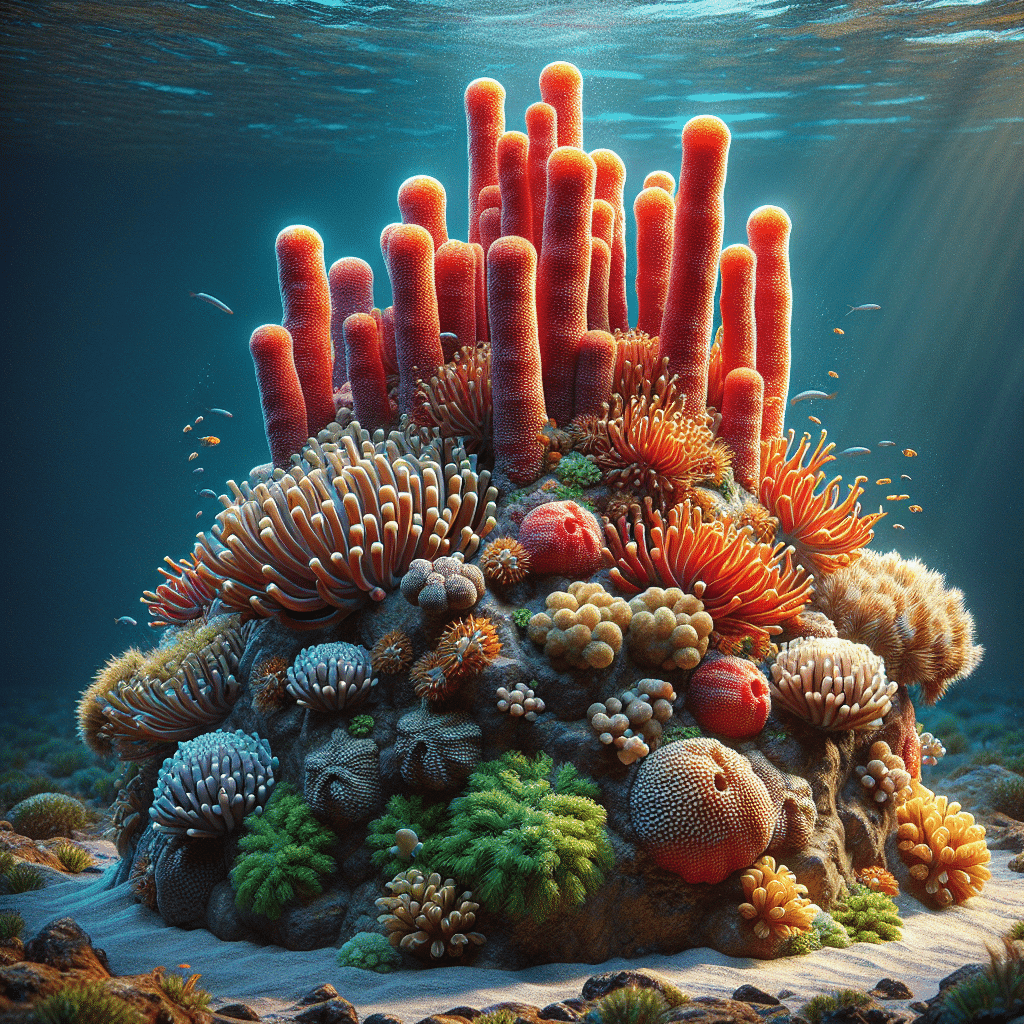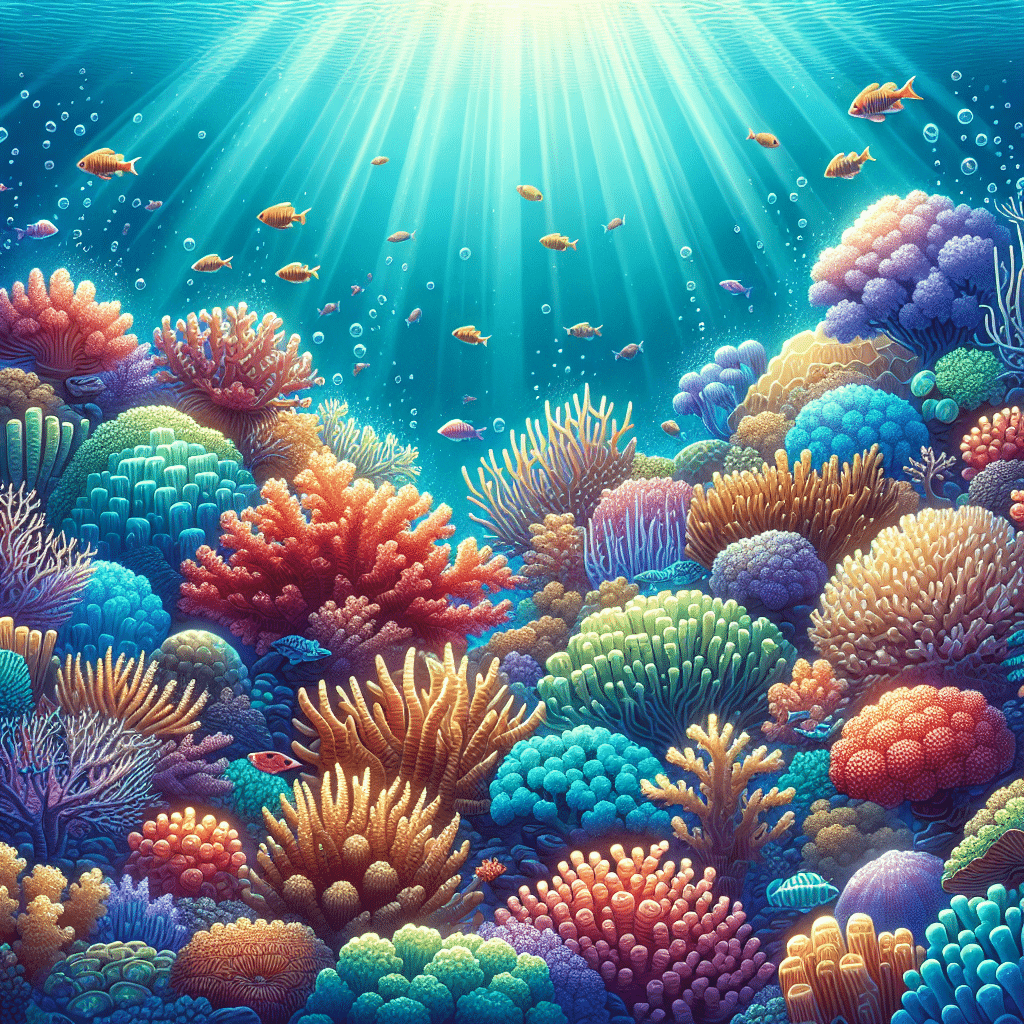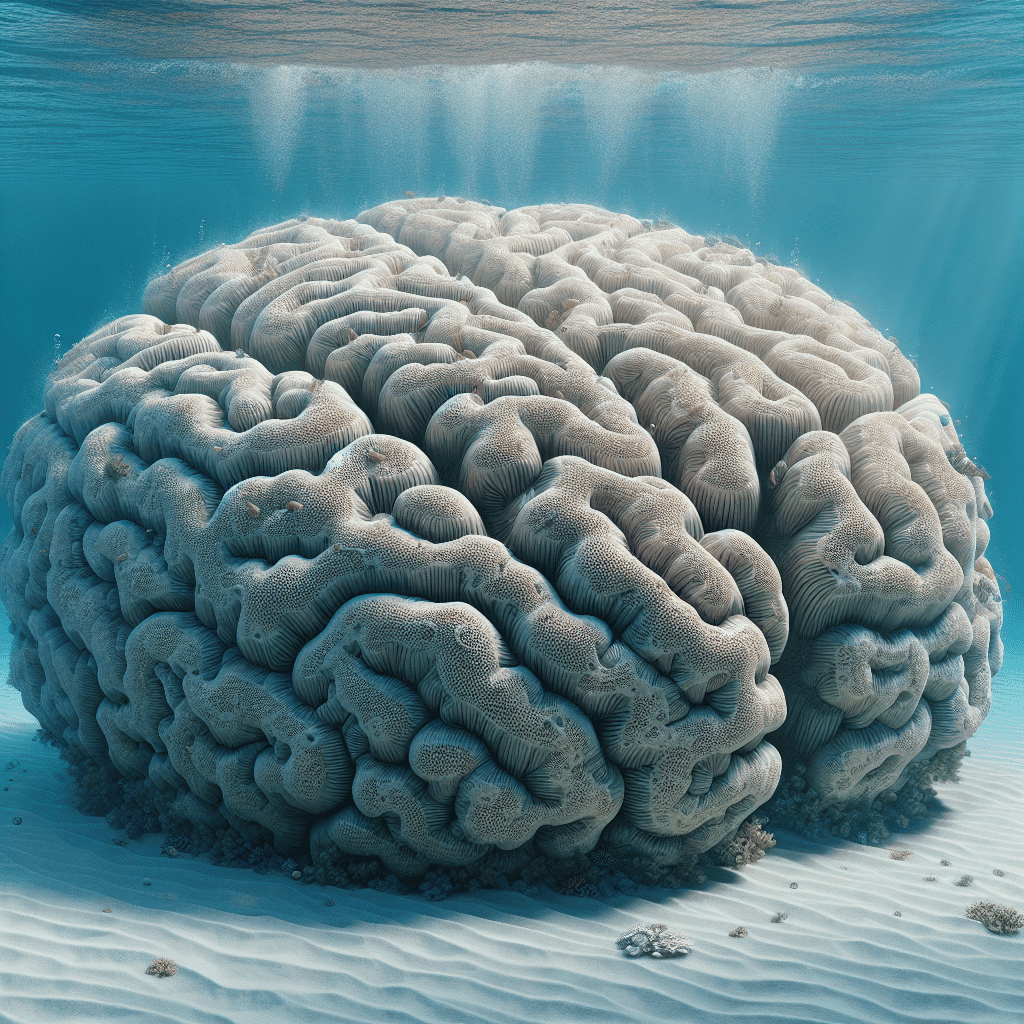Understanding Pillar Coral
Introduction to Pillar Coral
I love learning about different types of corals, and one that stands out is the pillar coral, scientifically known as Dendrogyra cylindrus. This hard coral is unique due to its tall, spire-like structures that can reach up to 2 meters in height. Found mainly in the shallow, tropical waters of the Caribbean and the southern Gulf of Mexico, pillar corals thrive at depths between 5 to 15 meters, though they can also survive in clear waters down to 25 meters. Their colonies are typically grey or brown and have a hairy appearance when their polyps are extended, giving them a distinct look in the reef tank environment.
Pillar corals are a type of hard coral (Scleractinia) that possess rigid exoskeletons, which protect their delicate, soft bodies. These corals usually form large colonies in flat, sheltered locations, making them an attractive addition to any reef tank setup. For more details about various coral types, check out our page on corals.
Importance of Pillar Coral
Pillar coral plays a vital role in the health of reef ecosystems. They provide structure and habitat for a variety of marine organisms, contributing to the overall biodiversity of coral reefs. The health of these corals is directly linked to the surrounding marine and terrestrial environments. For instance, healthy mangrove forests and seagrass beds are crucial as they stabilize the ecosystem and provide essential nutrients.
Moreover, pillar corals are indicators of reef health. Their presence often suggests a thriving ecosystem, while their decline can signal environmental stressors affecting the reef. Protecting these corals is essential not only for their survival but for the myriad of species that depend on them. If you’re interested in exploring other types of corals, you might want to read about brain coral or torch coral.
Understanding pillar coral is a critical step for any fish tank or reef tank hobbyist looking to create a balanced and thriving aquatic environment.
Habitat and Distribution
Native Range of Pillar Coral
Pillar coral, scientifically known as Dendrogyra cylindrus, thrives in the warm, shallow waters of the Caribbean and the southern Gulf of Mexico. I often find it fascinating that these corals can be spotted from the southern tip of Florida all the way down to Venezuela. They typically inhabit flat or gently sloping sheltered reef systems, usually at depths between 5 to 15 meters, although they can survive in clear waters down to 25 meters (Edge of Existence).
Here’s a quick overview of their native range:
| Region | Description |
|---|---|
| Southern Florida | Coastal areas with coral reefs |
| Bahamas | Shallow reefs and sheltered locations |
| Caribbean Sea | Warm tropical waters |
| Gulf of Mexico | Southern regions, often sheltered |
| Northern South America | From Colombia to Venezuela |
Pillar corals prefer to form colonies in flat, sheltered locations, creating large spires that can reach heights of up to 2 meters. They have a distinctive grey or brown color and a hairy appearance when their polyps are extended (Edge of Existence).
Ideal Conditions for Pillar Coral
For pillar coral to flourish, several ideal conditions must be met. They thrive in warm marine waters, typically between 24°C to 29°C (75°F to 84°F). Additionally, they prefer the following environmental factors:
| Factor | Ideal Conditions |
|---|---|
| Water Depth | 5 – 15 meters (up to 25 meters) |
| Temperature | 24°C to 29°C (75°F to 84°F) |
| Light | Moderate to high light levels |
| Water Quality | Clear, low nutrient levels |
Pillar corals are commonly found in areas with good water quality, which means low nutrient levels and clear visibility. The health and abundance of these corals are closely linked to surrounding ecosystems like mangrove forests and seagrass beds, which provide stability and nutrients for various marine life (Reef Relief).
When keeping pillar coral in a reef tank, it’s crucial to mimic these ideal conditions. Ensuring appropriate lighting and maintaining optimal water quality will help keep your coral healthy and thriving. For more on coral care, check out our articles on corals and specific coral types like brain coral or torch coral.
Characteristics of Pillar Coral
Physical Description
Pillar coral, known scientifically as Dendrogyra cylindrus, is a fascinating species found primarily in warm Caribbean waters. These corals can reach impressive heights, measuring between 6.5 to 8 feet (2 to 2.4 meters) and having diameters ranging from 2 to 5 inches (5.08 to 12.7 centimeters) (Florida Fish and Wildlife Conservation Commission).
The structure of pillar coral is quite unique. The skeleton resembles that of brain coral, with intricate meandering ridges and valleys. When the polyps extend, the coral takes on a hairy appearance, typically light-brown in color. The colonies form several large spires that may reach up to 2 meters in height, often found in flat, sheltered locations from the southern tip of Florida to the coast of Venezuela (Edge of Existence).
| Measurement | Size |
|---|---|
| Height | 6.5 – 8 feet (2 – 2.4 meters) |
| Diameter | 2 – 5 inches (5.08 – 12.7 centimeters) |
Reproduction and Growth
Pillar coral exhibits fascinating reproductive behavior. They harbor symbiotic zooxanthellae that provide energy through photosynthesis, but they also feed on zooplankton. This dual source of nutrition supports their growth and development. Spawning usually occurs in mid-August, about a week after the full moon, when the coral releases eggs and sperm into the water. This process is crucial for fertilization and the subsequent development of new colonies (Florida Fish and Wildlife Conservation Commission).
As a reef tank hobbyist, knowing about their growth patterns can help in planning the tank environment. Pillar corals thrive in shallow, tropical waters typically found at depths of 5 to 15 meters, although they can survive down to 25 meters in clear waters. Understanding their natural habitat is vital for providing the right conditions in a home aquarium.
For more insights into caring for your corals, check out our articles on corals and specific types like brain coral or torch coral.
Threats to Pillar Coral
Pillar coral, or Dendrogyra cylindrus, is facing numerous threats that jeopardize its survival and health. As a reef tank hobbyist, I find it crucial to understand these challenges to better care for this beautiful coral in my setup.
Environmental Threats
One of the biggest threats to pillar coral comes from environmental changes. Climate change is leading to increased ocean temperatures, which can cause coral bleaching. Bleaching occurs when corals expel the symbiotic algae living in their tissues, resulting in a loss of color and vital nutrients. This can make them more susceptible to diseases and reduce their chances of survival.
Additionally, hurricanes pose a significant danger. These storms can physically damage coral structures, uprooting and breaking apart colonies. The impact of strong waves and debris can lead to fragmentation, which hinders the coral’s ability to thrive.
Another environmental concern is bioerosion, primarily caused by sponges that can weaken coral structures over time. This slow degradation can significantly affect the overall health of coral reefs, including pillar coral.
| Environmental Threats | Description |
|---|---|
| Bleaching | Caused by rising ocean temperatures. |
| Hurricanes | Physical destruction from strong storms. |
| Bioerosion | Weakening of coral by sponges. |
Human-Induced Threats
Human activities also contribute to the decline of pillar coral populations. One significant threat is predation by damselfish, which can protect their territories aggressively, often at the expense of the coral.
Additionally, physical damage from anchors and boats can lead to direct harm. When boats anchor in coral-rich areas, they can drag, break, or uproot corals, leading to irreversible damage.
Pollution and coastal development further exacerbate issues for pillar coral. Increased sedimentation from land development can smother corals, while nutrient runoff can lead to algal blooms that compete with corals for space and resources.
| Human-Induced Threats | Description |
|---|---|
| Damselfish predation | Aggressive territorial behavior harming corals. |
| Physical damage | Damage from anchors and boats. |
| Pollution and sedimentation | Smothering and competition from algae. |
Understanding these threats is vital for anyone interested in coral care. By being aware of the risks, I can take steps in my reef tank to create a healthier environment for pillar coral and other corals like brain coral and mushroom coral.
Conservation Efforts
Protection Status of Pillar Coral
Pillar coral, scientifically known as Dendrogyra cylindrus, is currently listed as Critically Endangered on the IUCN Red List of Threatened Species. This status is due to several factors, including low recruitment and survival rates of juveniles, vulnerability to bleaching and diseases like white plague, and the destructive impact of hurricanes and tropical storms (Animalia).
In the United States, this species is functionally extinct in Florida and mainly survives in captivity. However, it receives legal protection under the Federal Endangered Species Act and is recognized as a Threatened species by Florida’s Endangered and Threatened Species Rule (Florida Fish and Wildlife Conservation Commission). Conservation efforts focus on safeguarding existing populations and restoring habitats where possible.
Conservation Programs
To combat the threats faced by pillar coral, various conservation programs have been implemented. These initiatives are designed to address the challenges posed by climate change, ocean acidification, and habitat degradation. Marine protected areas (MPAs) have been established to offer safe havens for pillar coral and other marine life, allowing ecosystems to recover from human-induced pressures (Edge of Existence).
Additionally, researchers and conservationists are working on monitoring and rehabilitating coral reefs to enhance the resilience of pillar coral populations. Public awareness campaigns aim to educate reef tank hobbyists and the general public about the importance of coral conservation. By promoting sustainable practices and responsible reef tank management, we can help protect these magnificent creatures for future generations.
| Conservation Efforts | Description |
|---|---|
| Legal Protection | Listed as Critically Endangered and protected under the Federal Endangered Species Act. |
| Marine Protected Areas | Establishing safe zones to protect coral habitats from human activity. |
| Research and Monitoring | Ongoing studies to track coral health and recovery efforts. |
| Public Awareness | Campaigns to educate the public on coral conservation and responsible reef tank practices. |
For more information on different types of corals that can thrive in reef tanks, check out my articles on brain coral, torch coral, and acropora. Together, we can contribute to the preservation of our ocean ecosystems and the incredible life within them.
Care and Maintenance
Taking care of pillar coral involves understanding the best placement, location, and feeding practices to ensure they thrive in a reef tank environment.
Placement and Location
When setting up my tank, I make sure to consider the ideal placement for pillar coral. These corals typically thrive in flat, sheltered locations. They are naturally found in the Caribbean and the Gulf of Mexico at depths ranging from 5 to 15 meters, though they can survive in clear waters down to 25 meters (Edge of Existence).
In my tank, I find that placing pillar coral in areas with moderate water flow helps keep them healthy. Too much flow can stress them, while too little can lead to stagnant water, which isn’t ideal. I usually position them on a stable surface where they can grow without being disturbed. The colonies can reach impressive heights of up to 8 feet (2.4 meters) and can have a diameter of 2 to 5 inches (5.08 to 12.7 centimeters) (Florida Fish and Wildlife Conservation Commission).
Feeding and Nutrition
Feeding pillar coral is essential for their growth and health. They rely on symbiotic zooxanthellae for energy through photosynthesis, but they also benefit from additional feeding. I typically feed my pillar coral zooplankton, which they can capture with their tentacles. These corals are great at utilizing the natural food available in the tank, so I ensure to provide a balanced diet.
I prefer to feed them small amounts several times a week, allowing them to consume what they can without overfeeding. It’s crucial to avoid excess food in the tank, as it can lead to poor water quality. For the best results, I keep an eye on how they respond to the feedings and adjust accordingly.
In summary, proper placement and feeding are vital for the well-being of pillar coral in my reef tank. By ensuring they have the right conditions and nutrition, I can enjoy the beauty and benefits they bring to my aquatic ecosystem. If you’re interested in learning more about caring for different types of corals, check out our articles on brain coral, black coral, and mushroom coral.
Disease Prevention
Common Diseases of Pillar Coral
Pillar coral is susceptible to several diseases, with white plague disease being one of the most notable. This disease results in rapid tissue loss and can severely impact the health of the coral. Other threats include bleaching, which is exacerbated by global climate change, and bioerosion caused by sponges. It’s essential to monitor these issues closely, as they can lead to significant declines in coral health.
Here’s a quick overview of common diseases and threats to pillar coral:
| Disease/Threat | Description |
|---|---|
| White Plague Disease | Rapid tissue loss affecting the coral. |
| Bleaching | Loss of color due to stress, often from heat. |
| Bioerosion | Damage caused by sponges weakening the structure. |
| Predation by Damselfish | Fish that may harm coral by eating polyps. |
| Physical Damage | Damage from anchors and boats. |
Disease Management
Managing the health of pillar coral involves a proactive approach. Regular monitoring of water quality and environmental conditions can help prevent stress-related diseases. Here are some steps that I take to keep my pillar coral healthy:
Water Quality: Maintain optimal water quality parameters. Regular testing for salinity, pH, nitrates, and phosphates is crucial.
Lighting: Ensure that the lighting is appropriate for the coral’s needs. Too much or too little light can stress the coral, leading to diseases.
Feeding: Provide proper nutrition through food designed for corals. This supports their health and can help combat stress.
Physical Protection: Minimize physical damage by positioning the coral in a safe location away from potential hazards like boat traffic.
Isolation and Treatment: If I notice signs of disease, I isolate the affected coral and consider treatment options. For instance, using appropriate medications or adjusting environmental conditions can often help.
Regular Maintenance: I perform regular maintenance on my tank, including cleaning and ensuring that other inhabitants do not harm the coral.
By taking these precautions, I can help ensure the health and longevity of my pillar coral. For more insights on managing different types of corals, check out our articles on brain coral and mushroom coral.
Lighting and Water Quality
Lighting Requirements
When caring for pillar coral, providing the right lighting is essential. These corals harbor symbiotic zooxanthellae, which play a crucial role in their energy acquisition through photosynthesis. Therefore, I need to ensure that my reef tank has adequate light to support these organisms. Generally, pillar corals thrive under moderate to high lighting conditions, typically ranging from 100 to 300 PAR (Photosynthetically Active Radiation).
| Lighting Type | Recommended PAR Range |
|---|---|
| LED Lights | 100 – 300 PAR |
| T5 Fluorescent | 150 – 250 PAR |
| Metal Halide | 200 – 400 PAR |
I usually position my lights to provide a balanced intensity throughout the tank, avoiding direct, harsh light that could cause stress or bleaching in the corals. It’s also a good idea to simulate a natural day-night cycle with a timer, giving my corals around 10-12 hours of light each day.
Water Quality Parameters
Maintaining optimal water quality is critical for the health of pillar coral. Here are some key parameters I keep an eye on:
| Parameter | Ideal Range |
|---|---|
| Temperature | 74°F – 82°F (23°C – 28°C) |
| Salinity | 1.023 – 1.025 SG |
| pH | 8.1 – 8.4 |
| Ammonia | 0 ppm |
| Nitrite | 0 ppm |
| Nitrate | < 5 ppm |
| Phosphate | < 0.03 ppm |
I regularly test these parameters to ensure they remain within the recommended ranges. Consistency is key; fluctuations can stress the coral and lead to problems like bleaching or disease. Additionally, I make sure to use high-quality salt mixes and perform regular water changes to keep the tank environment stable.
For more information on caring for corals, you might find these links helpful: corals, xenia, and brain coral. By paying attention to lighting and water quality, I can create a thriving environment for my pillar coral and other reef tank inhabitants.



